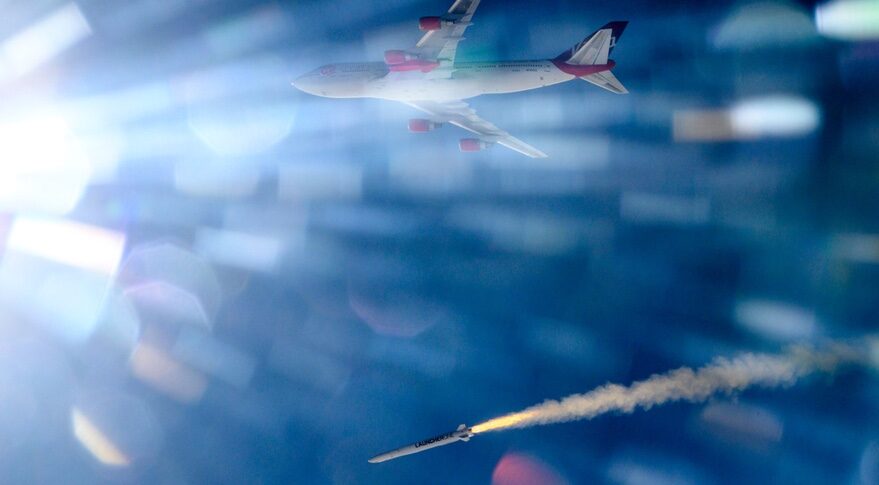
Virgin Orbit projects growth despite widening loss (Image Credit: Space News)
WASHINGTON — Despite a widening loss in the first quarter, Virgin Orbit executives said they believe they have enough financial runway for their air launch business to gain altitude this year.
In its first quarter financial results released May 11, the company announced a net loss of $62.6 million and an adjusted earnings before interest, taxes, depreciation and amortization (EBITDA) loss of $49.6 million. The company reported revenue of only $2.1 million in the quarter.
The results were significantly worse than the same quarter of 2021, when Virgin Orbit had revenue of $5.5 million, a net loss of $32.3 million and adjusted EBITDA loss of $29 million. As in the first quarter of this year, Virgin Orbit conducted a single LauncherOne mission in the first quarter of 2021.
The company blamed the loss on “expected revenue recognition of contract losses given our initial low-rate production phase” as well as higher expenses associated with being a public company. Virgin Orbit went public when it closed its merger with a special purpose acquisition company (SPAC) in late December.
In an earnings call, Brita O’Rear, chief financial officer at Virgin Orbit, said the low revenue was linked to “introductory pricing” the company offered on initial LauncherOne missions. In its first three operational launches, the company averaged just $2.5 million in revenue per launch. Upcoming “near-term” launches, she said, will generate revenue of $6 million to $12 million each.
“We see a progression of higher revenue per launch as our contracts now reflect increased customer confidence given our proven technology and the transition into recurring operations,” she said.
Dan Hart, Virgin Orbit’s chief executive, said the high end of that per-launch revenue range would likely be linked to national security and other government launches, as well as those taking place outside the United States. “International flights will garner a higher revenue. It’s a unique and differentiated capability,” he said. By contrast, a commercial launch to a standard orbit like sun-synchronous orbit would be at the low end of that revenue range because of the competition with other vehicles.
Virgin Orbit had negative free cash flow of $66.6 million in the quarter, and with $127 million in cash as of the end of the quarter, analysts on the call asked if the company would soon need to raise additional capital. O’Rear said the first quarter should have the highest cash outflow of the year for the company.
“Right now, we see our cash burn improving through the year,” she said, stating that the company has “sufficient liquidity” to get through the year without raising more capital. The company announced in March a standby equity purchase agreement with a hedge fund, Yorkville Advisors, to sell up to $250 million in equity over three years. Virgin Orbit has yet to exercise that agreement, she said.
Virgin Orbit did not provide projections of revenue or losses for the second quarter or the rest of the year in the earnings release. The company, which at the beginning of the year projected six launches in 2022, will conduct only its second launch of the year, and the first since January, no earlier than June 29. That mission, called “Straight Up” by the company, will carry seven U.S. government payloads on a launch procured by the U.S. Space Force.
Hart said the following LauncherOne mission will be the long-awaited first launch from the United Kingdom, flying out of Spaceport Cornwall. That launch is scheduled for the third quarter, pending licenses from the British government for both the launch and the spaceport. Hart said that after the Cornwall launch the company will perform “additional launches” back at Mojave Air and Space Port, but did not provide a formal estimate of the number of launches it now anticipates conducting in 2022.
In anticipation of a higher launch rate, Virgin Orbit announced May 10 an agreement with L3Harris to acquire and modify two additional Boeing 747 aircraft. One of those planes would be ready “as early as 2023,” Hart said on the call. Having a second plane would allow the company to maintain a launch cadence if its current plane, dubbed “Cosmic Girl,” needs maintenance, and permits the company to conduct launches in two different locations.
He declined, though, to say how much it will cost to acquire and modify the two planes. “We’re in the middle of discussions on those, and we have a couple of attractive options.”
The company also declined to say what launch rate the company needs to break even. “We haven’t been sharing the number of launches to break even,” Hart said. “We’ll consider that as we go forward.”








